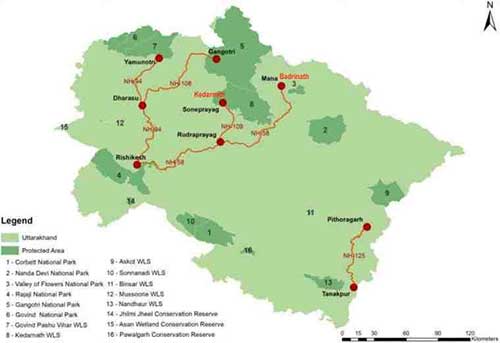Relevance: GS-3: Conservation, environmental pollution and degradation, environmental impact assessment
Key phrases: High Powered Committee (HPC), Badrinath, Kedarnath, Gangotri, Yamunotri, Chardham Mahamarg Vikas Pariyojna, judge AK Sikri, Main Central Thrust
Why in News?
- Recently, Ravi Chopra , an environmentalist and chairman of the Supreme Court-appointed High Powered Committee (HPC) to oversee the execution of the marquee Char Dham road-widening project has resigned, saying that the panel to protect the Himalayas “has been shattered.”
- The Supreme Court on December 14 allowed double-lane widening of roads for the project in view of “security concerns”. Mr. Chopra and some members of the HPC had previously argued against such widening.
About Chardham:
- The Char Dham (meaning: four abodes) is a set of four pilgrimage sites in India. The Char Dham as defined by Adi Shankaracharya consists of four Hindu pilgrimage sites- Badrinath, Dwarka, Puri and Rameswaram.
- However, another small circuit in Uttarakhand of four pilgrimage sites:- Yamunotri, Gangotri, Kedarnath, and Badrinath are also referred to as Chota Chardham or Chardham.

About Chardham project in Uttarakhand:
- The project involves developing and widening 900-km of national highways connecting the holy Hindu pilgrimage sites of; Badrinath, Kedarnath, Gangotri, and Yamunotri at an estimated cost of Rs.12,000 crores.
- The highway will be called Chardham Mahamarg(Char Dham Highway) and the highway construction project will be called Chardham Mahamarg Vikas Pariyojna(Char Dham Highway Development Project).
- National Security angle : This project can act as the strategic feeder roads which connect the India-China border with the Army camps in Dehradun and Meerut where missile bases and heavy machinery are located.
What is the controversy?
- The Supreme Court formed a high-powered committee (HPC) to examine the issues. In July 2020, the HPC submitted two reports after members disagreed on the ideal width for hill roads.
- Deforestation:
- In 2018, the road-expansion project was challenged by an NGO for its potential impact on the Himalayan ecology due to felling trees, cutting hills and dumping muck (excavated material).
- Terrain damage: It was observed that a wider road requires additional slope cutting, blasting, tunnelling, dumping and deforestation.
- Increasing vulnerability: All of this will further destabilise the Himalayan terrain, and increase vulnerability to landslides and flash floods.
Supreme Court observations
- A three-judge Supreme Court bench modified an earlier, September 2020 order by another three-judge bench directing that three highways being laid as part of a 899-km road network in Uttarakhand should stick to a width of 5.5 metres for the carriageway.
- Following a review sought by the Defence Ministry, the Supreme Court has now decreed that the width of the roads can be of 10m as sought by the Centre, paving the way for their double-laning.
- Acknowledging the strategic importance of the three highways - which act as feeder roads for connecting with the China border - the top court also noted the need for balancing such priorities with environmental concerns.
- It also ordered the setting up of an oversight committee led by former Supreme Court Judge J. AK Sikri to ensure that the works were executed in an environmentally conscious manner, incorporating the recommendations of a high-powered committee in this regard.

Advantages of Chardham Project
- The project will make travel to Char Dham safer and more convenient.
- Connectivity & tourism will get a strong boost through the project.
- Proper slope stabilisation will ensure protection against landslides.
- The project is also important from a strategic point of view as it is close to the China border.
- In the eventuality of any aggression, improved roads will facilitate movement of heavy weapons, equipments and artillery guns.
Concerns regarding Chardham Project
- It is an extremely fragile region. The area forms the Main Central Thrust of the Lesser Himalayan region.
- This is where the Indian tectonic plate goes under the Eurasian Tectonic Plate.The phenomenon makes the region susceptible to earthquakes and landslides.
- The Geological Survey of India corroborates this in its report prepared after the Kedarnath disaster. It states that road construction in mountains reactivates landslides as it disturbs the toe of the natural slope of the hill.
- Recently, many landslides in Uttarakhand are seen related to the Chardham project.
Conclusion
- Infrastructure development is necessary for India to continue its track as the fastest growing economy.
- Safety and security of the thousands of pilgrims, inclusive development of all communities and such other are responsibilities of the government. But the environment is also equally important.
- Thus we need to strike a fine balance between our development goals and environment protection.
- It must be noted that NGT and SC both have given green signal to the project, their decision must be on the basis of merits and intended towards greater good.
Mains Question:
Q. Discuss the impact of Chardham project on disaster vulnerability, biodiversity and ecology of Himalayan regions of Uttarakhand.( 15 marks)
Source: The Hindu BL









